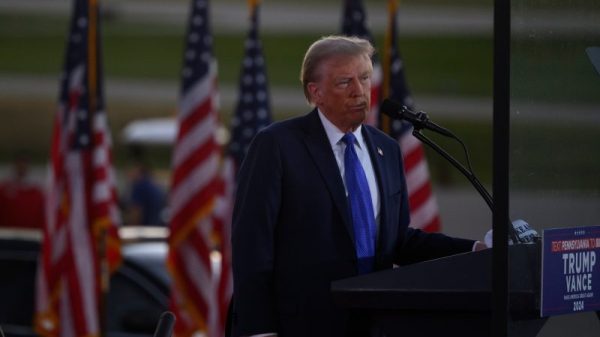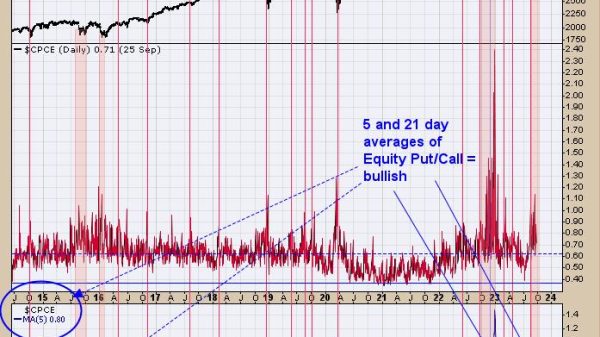Donald Trump, the 45th president of the United States, has been criminally indicted a third time — twice on charges leveled by special counsel Jack Smith.
Smith previously charged Trump with failing to return classified documents he took when he left the White House and obstructing the government’s efforts to retrieve them. On Tuesday, a federal grand jury indicted Trump for his alleged attempts to overturn the 2020 election — attempts that culminated in an attack by his supporters on the U.S. Capitol on Jan. 6, 2021.
Trump is charged with four counts: conspiracy to obstruct and obstructing an official proceeding — the same charges brought against many of the hundreds of Jan. 6 defendants — as well as conspiracy to defraud the United States and conspiracy to violate the right to vote.
Trump was already facing a calendar-spanning series of court dates during the 2024 presidential campaign, including a Manhattan trial on charges related to an alleged hush money scheme during the 2016 election campaign.
The Republican Party has rallied to him despite it all — or perhaps because of it — leaving him an increasingly strong favorite to be the party’s 2024 presidential nominee.
Below are some takeaways from this latest, arguably most significant indictment.
It’s a question that has long stalked Trump: whether he knew that the false things he said were false. It’s also a threshold question when it comes to the case ahead, given that Trump’s defense will apparently rely on the idea that he somehow believed his claims about a stolen election and thus didn’t act corruptly.
Smith is unambiguous: Trump knew better.
“The Defendant spread lies that there had been outcome-determinative fraud in the election and that he had actually won,” the indictment says. “These claims were false, and the Defendant knew that they were false.”
Smith cites examples — many previously known — of those around Trump directly informing him that his claims were false and his schemes dubious. They included Vice President Mike Pence, top Justice Department officials, top White House attorneys and campaign staff, key state legislators and officials, and state and federal courts.
The indictment cites examples of Trump’s being informed that specific claims were false and then proceeding to lodge them anyway. Smith makes a point of isolating a single claim from each of five key states — Arizona, Georgia, Michigan, Nevada and Pennsylvania — each time punctuating the example by saying that Trump “repeated his knowingly false claim” on Jan. 6 itself.
One such example: Both Trump campaign manager Bill Stepien and Republican Arizona state House Speaker Rusty Bowers told Trump in November 2021 that there weren’t tens of thousands of noncitizens who voted in Arizona. But Trump made this claim on Jan. 6 anyway, nearly two months after Stepien tried to disabuse him of it.
While the House select committee on Jan. 6 presented much of the evidence last year, the indictment does break some ground in suggesting that Trump knew this was corrupt. It cites a vivid scene from Jan. 1, 2021, in which Pence resisted Trump’s renewed appeal to overturn the election in Congress on Jan. 6, with Trump allegedly telling Pence, “You’re too honest.”
Trump is also described as acknowledging that claims about voting machines by “Co-Conspirator 3” (apparently Sidney Powell), which he would echo repeatedly, were unsupported. (We learned from Trump spokeswoman Hope Hicks’s Jan. 6 committee testimony that Trump said Powell sounded “crazy,” but not necessarily that he acknowledged this theory was baseless.)
The defense that’s left for Trump is that he was told all of this but disregarded it or thought he knew better, which is apparently what his lawyers will suggest.
“I would like them to try to prove beyond a reasonable doubt that Donald Trump believed that these allegations were false,” lead Trump lawyer John Lauro said on Fox News on Tuesday night.
The indictment Smith unveiled Tuesday appears intended to isolate Trump, perhaps in the service of emphasizing that he was the central figure in all of this and not just someone strung along by lawyers and advisers. (An eye toward a speedier trial might also have been a reason for indicting Trump solo.)
But that doesn’t mean others are out of the woods. After all, conspiracies involve multiple people.
Six unnamed “co-conspirators” figure into the indictment’s narrative. We can identify five based on the context: Trump lawyers Rudy Giuliani, John Eastman and Sidney Powell, along with former Justice Department official (and Trump’s would-be acting attorney general) Jeffrey Clark and Trump-aligned attorney Kenneth Chesebro. The sixth “co-conspirator,” a political consultant, isn’t so clearly identifiable.
Giuliani is invoked the most — more than 40 times — and Eastman is cast as instrumental to what the indictment labels the “fraudulent electors” scheme.
Both Eastman and Clark also feature in two scenes that Smith included alluding to the prospect of violence.
In one, a Trump adviser cites the possibility of Eastman’s strategy to have Pence help overturn the election on Jan. 6 causing “riots in the streets.” Co-conspirator 2 (Eastman) responds by saying violence is at times necessary for the republic.
That instance was previously reported, but the other was not: A White House lawyer, according to the indictment, said there would be “riots in every major city in the United States” if Trump stayed in office. Co-Conspirator 4 (Clark) responded by saying, “Well … that’s why there’s an Insurrection Act.” (The Insurrection Act empowers the president to deploy the military to put down civil unrest in certain circumstances.)
Smith seems to include these scenes as evidence that the tactics were extreme and even that violence was foreseeable, but that Trump and his allies pressed on anyway.
As for whether others might be charged, Smith said in a brief statement Tuesday night, “Our investigation of other individuals continues.”
One thing that comes through in the indictment is how so much of Trump’s and his alleged co-conspirators’ actions involved creating pretexts and essentially taking advantage of other people, in Smith’s telling.
That applies particularly to the alternate electors, some of whom have now been indicted by a state prosecutor.
The Trump campaign publicly pitched the alternate electors as a contingency in the event states overturned their own results — the idea being that they would be used only in that circumstance. But Smith says the effort, from its early days, was really about creating the illusion of uncertainty on Jan. 6 regardless of what states did.
“Under the plan, the submission of these fraudulent slates would create a fake controversy at the certification proceeding” on Jan. 6, the indictment says.
Smith cites how, on the eve of the Dec. 14 deadline for electors to be declared, Trump aides declined to put out a statement about the move to advance alternate slates because none of them could “stand by it.” One top official called it “a crazy play so I don’t know who wants to put their name on it.” An adviser labeled it “certifying illegal votes.”
At another point, a campaign aide worried about how the Pennsylvania alternate electors wanted to say that they were duly elected only if the results in their states were overturned. The aide said, “If it gets out we changed the language for PA it could snowball” into other states.
Only two of seven slates of fake electors wound up offering such a qualifier; those in Michigan, who didn’t, were recently indicted.
There is evidence that some involved in the fake elector scheme worried that this effort would break the law. In the days leading up to Dec. 14, Smith notes in the indictment, Co-Conspirator 5 (Chesebro) said that Co-Conspirator 1 (Giuliani) had learned that declaring alternate electors in Arizona without a pending court case could “appear treasonous.”
Smith also notes that such a lawsuit was filed in New Mexico just six minutes before the deadline for electors on Dec. 14. He labels it “a pretext so that there was pending litigation there at the time the fraudulent electors voted.”
Smith calls the alternate elector plot a “sham” — a word he also uses for the voter fraud investigations Trump pushed.
Smith’s repeated references to Trump’s saying Powell sounded “crazy” certainly fit the idea that Trump was using her to build a pretext.
And rather than entertain the idea that Trump merely urged protesters to go to the Capitol to protest, as Trump claims, Smith says Trump “directed them to the Capitol to obstruct the certification proceedings.”
The language is telling; it suggests that the disruption was the purpose, not an unintentional byproduct.
All of this points to Smith’s arguing that these schemes were engineered to try to overturn the election on false pretenses, using whatever blunt instrument was available.
The GOP’s reactions to Trump’s legal problems is seemingly baked in at this point; Republicans overwhelmingly claim he’s being persecuted or treated differently from Democrats, without engaging on the merits of the allegations.
But Trump’s actions related to Jan. 6 and his false voter fraud claims did draw significant GOP criticism after the insurrection. And there were signs Tuesday night of some reluctance to defend him.
Pence, who is running against Trump for the 2024 GOP presidential nomination, has previously alluded to the idea of a two-tiered system of justice. But his post-indictment statement made no mention of that, instead emphasizing his view that Trump’s plan for him violated the Constitution.
“Today’s indictment serves as an important reminder: anyone who puts himself over the Constitution should never be President of the United States,” Pence tweeted. Pence added that he will offer more thoughts when he can review the indictment.
Florida Gov. Ron DeSantis (R), Trump’s top 2024 primary opponent, offered a thoroughly muted response. He broadly cited the supposed “weaponization” of the government, but otherwise said he was reviewing the indictment and talked merely about how such cases should perhaps not be tried in Washington, D.C.
Several Republicans did point to the idea of unequal justice, including fellow 2024 contender Sen. Tim Scott (R-S.C.) and Trump loyalists such as Rep. Elise Stefanik (R-N.Y.), Rep. Marjorie Taylor Greene (R-Ga.) and Sen. Marsha Blackburn (R-Tenn.). But the reaction from the GOP was generally muted; few put out statements or social media posts at all.
The tendency of the GOP is to fall in line; Trump’s numerous controversies have reinforced that that is the easy and most politically expedient play, particularly since he is the strong favorite to lead the Republican ticket in 2024.
But the strength with which Republicans actually defend him can also be telling. And Tuesday night, the response wasn’t that strong — particularly compared to Trump comparing his prosecution to “Nazi Germany.”





























